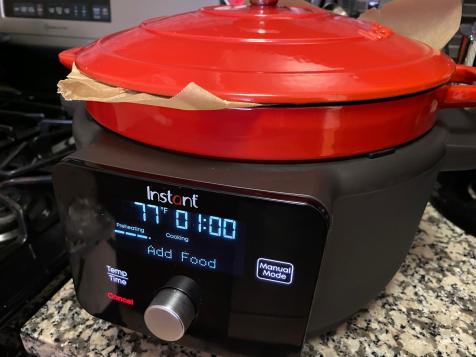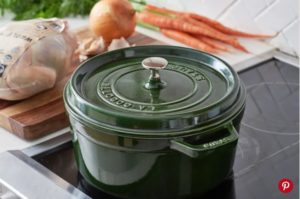An electric Dutch oven is a cooking appliance that combines the traditional design of a Dutch oven with the convenience of an electric cooker. Unlike traditional Dutch ovens, which are designed to be used over an open flame or in a conventional oven, electric Dutch ovens plug into an electrical outlet and use electricity to heat the cooking surface.
These appliances are often used for slow-cooking dishes, such as stews, roasts, and soups, and can be a convenient and versatile addition to any kitchen. Electric Dutch ovens typically have a non-stick cooking surface, temperature control settings, and a removable lid for easy cleaning. They come in various sizes and designs to fit the needs of different households.
What can electric Dutch oven be used for?
An electric Dutch oven can be used for a wide variety of cooking tasks, from slow-cooking stews and soups to roasting meats and vegetables. Some common uses of an electric Dutch oven include:
- Braising: The electric Dutch oven is perfect for braising meat, as it allows for even heating and precise temperature control.
- Slow cooking: An electric Dutch oven is perfect for slow-cooking stews, soups, and chili, as it can maintain a low, consistent temperature over a long period of time.
- Baking: Some electric Dutch ovens come with baking settings that allow you to bake bread, cakes, and other desserts.
- Roasting: You can use an electric Dutch oven to roast chicken, pork, beef, and other meats, as well as vegetables.
- Frying: Some electric Dutch ovens come with frying settings that allow you to fry chicken, fish, and other foods.
In general, an electric Dutch oven can be used for any cooking task that requires even heating, precise temperature control, and a covered cooking surface. It is a versatile and convenient appliance that can help you prepare a wide range of delicious meals with ease.
What do you cook in an electric Dutch oven?
An electric Dutch oven can be used to cook a wide variety of dishes, including:
- Braised meats: Beef, pork, and lamb all benefit from slow, low-heat braising in an electric Dutch oven. You can use the oven to create tender, juicy pot roasts, beef bourguignon, or lamb shanks.
- Soups and stews: The electric Dutch oven is perfect for slow-cooking hearty soups and stews. You can create classic dishes like beef stew or chicken noodle soup, or get creative with your own recipes.
- Roast chicken or turkey: An electric Dutch oven is great for roasting whole chickens or turkeys. The oven’s even heat distribution ensures that your bird will cook evenly and come out perfectly.
- Baked goods: Some electric Dutch ovens come with baking settings, allowing you to make bread, cakes, and other desserts.
- Casseroles: An electric Dutch oven is perfect for making baked pasta dishes, vegetable gratins, and other one-dish meals.
- Risotto: The oven’s precise temperature control makes it great for cooking creamy risotto dishes.
In general, the electric Dutch oven can be used for any cooking task that requires even heating and precise temperature control, making it a versatile and convenient appliance for home chefs.
What is the difference between an electric Dutch oven and a slow cooker?
An electric Dutch oven and a slow cooker are both great tools for slow-cooking meals, but there are a few key differences between the two:
- Cooking surface: An electric Dutch oven has a metal cooking surface that can be used for browning or searing meat before slow-cooking, whereas a slow cooker usually has a ceramic cooking surface that is not suitable for browning.
- Temperature control: An electric Dutch oven usually has more precise temperature control than a slow cooker, allowing you to adjust the heat more precisely. Some electric Dutch ovens even have digital temperature controls and timers.
- Cooking versatility: While both appliances are great for slow-cooking, an electric Dutch oven can often be used for a wider variety of cooking tasks, such as baking, roasting, and searing, whereas a slow cooker is typically limited to slow-cooking only.
- Portability: A slow cooker is usually more portable and can be easily transported to potlucks, parties, or other events, whereas an electric Dutch oven is bulkier and less portable.
Overall, both appliances have their own advantages and disadvantages, and the choice between them will depend on your specific cooking needs and preferences.
How to use electric Dutch oven
Using an electric Dutch oven is quite simple and straightforward. Here are the basic steps:
- Choose a recipe: Select a recipe that is suitable for slow-cooking and that you would like to make in the Dutch oven.
- Prep ingredients: Prep all the ingredients according to the recipe instructions.
- Brown meat (if necessary): If the recipe requires browning or searing meat before slow-cooking, you can use the electric Dutch oven’s metal cooking surface to do this.
- Add ingredients: Once the meat is browned (if necessary), add all the ingredients to the electric Dutch oven.
- Select cooking temperature: Set the temperature to the appropriate level for the recipe. Most electric Dutch ovens have temperature controls that range from low to high, with some models offering more precise temperature control.
- Set cooking time: Set the cooking time according to the recipe instructions. Many electric Dutch ovens also have built-in timers that will automatically turn off the heat when the cooking time is complete.
- Monitor cooking: Check on the cooking progress occasionally, stirring the ingredients if necessary.
- Serve: Once the cooking time is complete, turn off the heat and let the dish sit for a few minutes before serving.
It’s important to follow the manufacturer’s instructions for your specific electric Dutch oven, as the features and settings may vary depending on the model.
How to clean electric Dutch oven
Cleaning an electric Dutch oven is a relatively simple process. Here are the steps you can follow:
- Unplug the Dutch oven: Make sure the electric Dutch oven is unplugged and has cooled down before cleaning it.
- Remove any excess food or debris: Using a non-abrasive sponge or cloth, wipe out any leftover food or debris.
- Wash the inner pot: Remove the inner pot from the electric Dutch oven and wash it with warm, soapy water. Do not use abrasive cleaners or harsh scrubbing pads as they can damage the non-stick coating or the surface of the pot.
- Clean the exterior: Wipe the exterior of the electric Dutch oven with a damp cloth or sponge. Avoid using harsh chemicals or abrasive cleaners, which can damage the finish.
- Dry the parts: Dry the inner pot and exterior of the electric Dutch oven with a clean, dry cloth.
- Store: Once the electric Dutch oven is completely dry, you can store it in a cool, dry place until the next use.
It’s important to refer to the manufacturer’s instructions for specific cleaning and care instructions for your particular electric Dutch oven model.
How long does it take to use electric Dutch oven?
The length of time it takes to use an electric Dutch oven will depend on what you are cooking and the cooking temperature required. Like traditional Dutch ovens, electric Dutch ovens can be used to cook a variety of dishes, such as stews, soups, roasts, and even desserts. The cooking time will vary depending on the recipe and the temperature setting used.
Most electric Dutch ovens have temperature settings that range from low to high, and some models also include a “keep warm” setting. Cooking times will vary depending on the recipe, the temperature setting, and the size and type of ingredients being used. For example, a pot roast cooked on low heat may take 6-8 hours, while a vegetable soup cooked on high heat may take only 2-3 hours.
It’s important to refer to the manufacturer’s instructions for recommended cooking times and temperature settings for your particular electric Dutch oven model, as these can vary depending on the unit.
Tips for using electric Dutch oven
Here are some tips for using an electric Dutch oven:
- Preheat the unit: Just like an oven or stovetop, it’s important to preheat your electric Dutch oven before adding your ingredients. This will ensure that the temperature is even throughout the cooking process.
- Use the right temperature setting: Most electric Dutch ovens have temperature settings that range from low to high, and some models also include a “keep warm” setting. Be sure to refer to the manufacturer’s instructions for recommended cooking times and temperature settings for your particular model.
- Don’t overfill the unit: It’s important not to overfill your electric Dutch oven, as this can cause the food to cook unevenly. Be sure to leave enough room for the food to expand as it cooks.
- Use the right size: Use the appropriate size electric Dutch oven for the amount of food you’re cooking. A smaller unit may be more efficient for smaller meals, while a larger unit can accommodate larger dishes.
- Keep the lid on: It’s important to keep the lid on your electric Dutch oven while cooking, as this will help to retain moisture and heat, ensuring even cooking.
- Stir occasionally: Some recipes may require stirring or turning the ingredients during the cooking process to ensure even cooking. Be sure to refer to the recipe and stir as needed.
- Clean after each use: Be sure to clean your electric Dutch oven after each use according to the manufacturer’s instructions. This will help to ensure that your unit remains in good working order and will prolong its lifespan.
Related Posts
STAUB Pumpkin Dutch oven
Disclaimer: There are affiliate links in this post. At no...
Read MoreWhat is the best Dutch oven for roast?
Disclaimer: There are affiliate links in this post. At no...
Read MoreBest Dutch Oven for Induction Cooktops
Disclaimer: There are affiliate links in this post. At no...
Read MoreBest Dutch Oven For Glass Top Stove
Disclaimer: There are affiliate links in this post. At no...
Read MoreWhy Trust Us
You will find what you are looking for at dulceriabakery. From classic to luxury brands, you'll find both. We will help you to select appliances that fit your needs, budget and lifestyle. Whether you want to stop by to learn more — or plan to make a major purchase — we’ll treat you like family and assist you every step of the way. Shop with us today to receive friendly and experienced help along the way.




